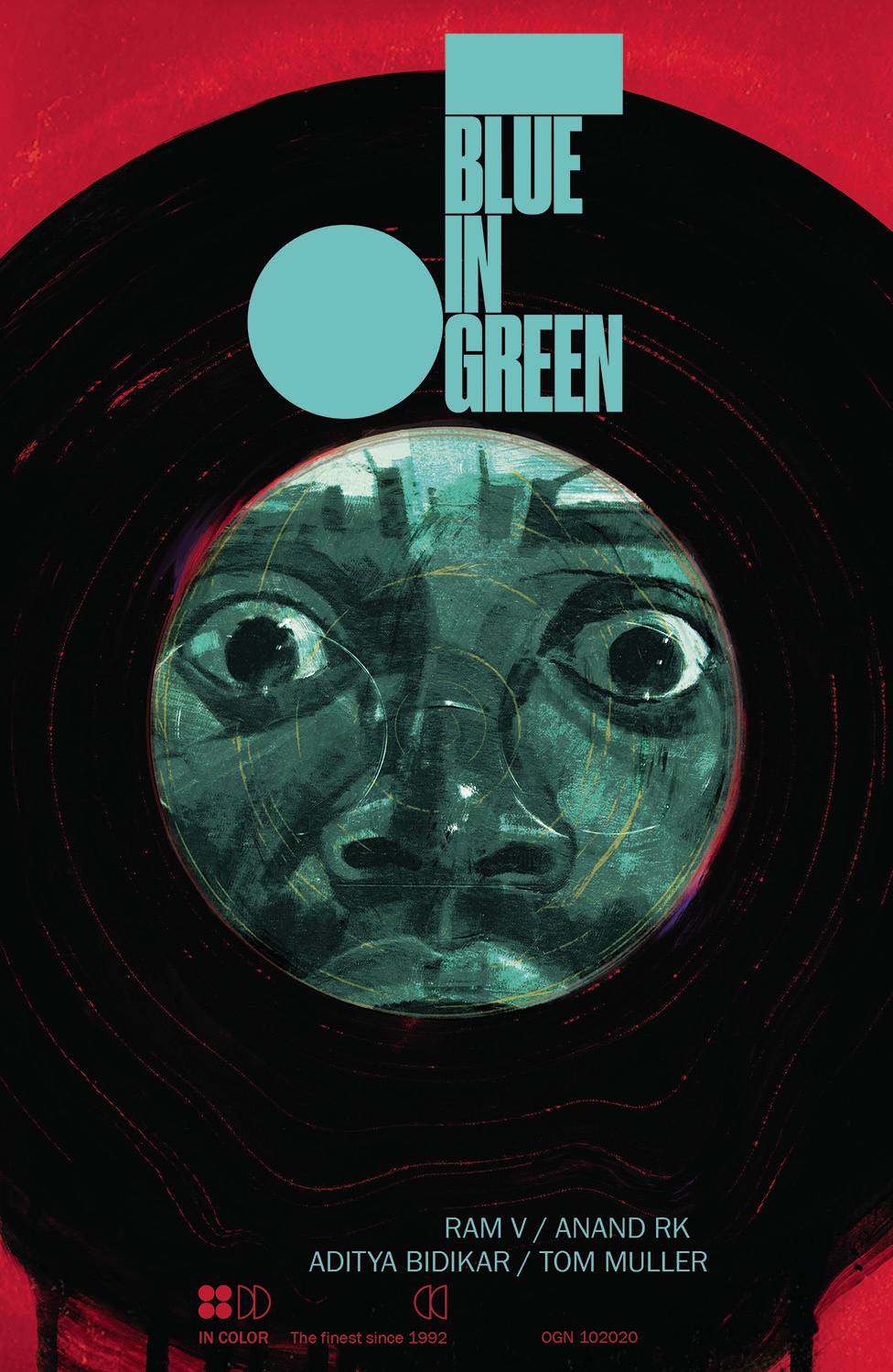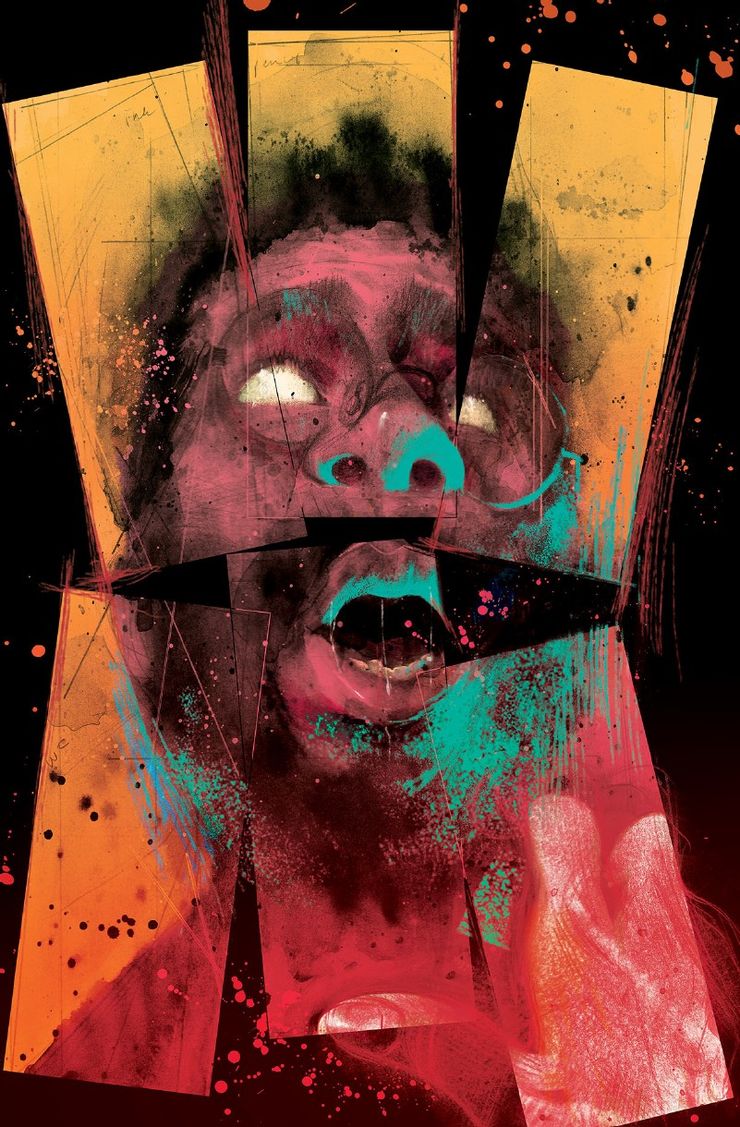Ram V aims for "dread, tension, anxiety, and unease" in jazz horror OGN Blue in Green with Anand Rk
Image Comics' new horror OGN Blue in Green has a certain jazz to it

Over the last few years, writer/artist Ram V has been slowly building his own canon of original horror works; standalone OGNs, all of which deal with some manner of horror subgenre. This week, he adds a new work to that canon with the debut of Blue in Green, a new horror OGN from Image Comics reteaming him with collaborators Anand Rk and Aditya Bidikar.

Scripted by V, lettered by Bidikar, penciled by Rk, and colored by John Pearson, Blue in Green tells the story of Erik Dieter, a saxophonist and music teacher who is called back to his hometown after the death of his mother.
But as he lingers in his former home, the discovery of a strange photograph of a mysterious musician, something of a local legend, starts to dominate his thoughts, turning from curio to obsession. This obsession reveals Erik's own dark ambition and pulls him deeper into a world of shady gig managers, the price of fame, and unknowable cosmic horrors from beyond the veil of reality. Think H.P. Lovecraft's 'The Music of Erich Zann' meets Miles Davis' A Love Supreme (the latter of which delivering the OGN's title, a callback to one of Miles' songs).
Newsarama recently got a chance to talk to Ram V about Blue in Green, tracking its production genesis, Ram's 'theory of horror', and the history and feel of Jazz as the cornerstone of this new story. Drink full these dark delights and lose yourself to the sound of a new kind of historical horror in Blue in Green.
Newsarama: Ram, what were the first seeds of Blue in Green? It's rooted in so much, from music, to history, and then into cosmic horror, but how did it start from your end, production-wise?
Ram V: I'd always been interested in jazz from an early age. I wanted to do something with that interest, that aesthetic, and my experiences with it. I'd also known that I wanted to work on something with Anand that utilized his more 'painted' style. So while we were working on Grafity's Wall, Anand and I began discussing this project (among others).
I also drew on a lot of influences for this - Angel Heart and Whiplash among many others. I find that this happens a lot with my ideas/collaborations. I talk about them and let them hang around long enough at the idea stage until it all reaches some kind of critical mass and I finally have enough to turn into a story!
Get the best comic news, insights, opinions, analysis and more!

We pitched the book to Image Comics sometime last year, got the green light, and have been working on it ever since!
Nrama: You mention Anand's painted style, did that affect the way you scripted the piece in any way?
I would imagine it's far different than your scripts for monthly comics, but did your conversations with your art team inform how you wrote for them on the page?
V: We knew from the very beginning of the book that we were going to use this painterly style that Anand had and so the script did lean into using that. We knew we could instantly juxtapose the insinuated realism of portraiture with more abstract and surrealist visuals without losing visual cohesion and I think that's something we were able to do with the book.
Outside of that, we tried an interesting thing with the narrative here. I worked without an outline and without planning too far in advance. Each page is written in reaction to the art on the previous page. Almost like we were improvising the story, letting the narrative take us where it may - like jazz!

Nrama: How important was it for you, scripting wise, to deliver a 'true' account of jazz as a genre for comics?
Meaning, you obviously operate in a narrative that feels researched and lived in (while also exploring horror elements as well), but was there a part of you that really wanted to get the details or history of the movement correct?
V: To an extent.
I think research can be a delicate balance when it comes to how much time and work you put into it when you're writing a story. I tend to research things as and when I need them. My effort is to try and avoid incongruences rather than focus too much on accuracy. Accuracy outside of what helps me tell the story is a waste of time and frankly, unless that accuracy ties in really well into the narrative, it can deaden the story.
I've certainly seen stories where the author's need to demonstrate their research has overtaken the drive to tell an evocative, involving story and so, I'm wary of that.
As far as tying in Jazz and the visual aesthetic of the book, that's all purely 'feel' - an artistic drive to use images that invoke the auditory senses and feelings of listening to Jazz. That's less research and more tapping into the emotion and images that the music evokes for me.

Nrama: Absolutely. Plus, especially with something like this, you don't want to over detail it, as it might stiffen the story with facts and subtract from the overall vibe.
But how have you handled the shifts from monthly work-for-hire-comics to full-tilt OGNs? Was the extra length a burden or an opportunity to push it further than you expected it to go?
V: Ah, it hasn't been a shift to be honest.
Since first publishing Black Mumba in 2016, I have published long-form OGNs pretty much every year and a half (Grafity's Wall previously in 2018), alongside doing creator-owned work that's come out as monthlies and more recently 'supers' at DC and Marvel.
I promised myself a long while back that I would always be working on a more personal long-form project, regardless of what else I had going on at the time. So the transition into working on Blue in Green was seamless and I also know what my next long-form project will be. I intend to start on that sometime in 2021!
Nrama: So you are arguably building your own 'canon' of genre works outside of the world of work for hire.

But with that being said, what is it about horror and the OGN format that speaks to you personally? I would guess the freedom and room to allow the work to breathe are big pluses, but what is it about horror specifically that activates you as a creator?
V: The OGN format certainly allows for a long more creative room. I don't just mean the real estate in terms of page count. But it lets you do things with writing and constructing a narrative that you might not be able to do with something more episodic. Varying chapter lengths, for instance. Or the fact that we improvised the story, writing and developing the thing one page at a time. I don't think these would have been viable things to do with an episodic format.
As for horror, I have my own peculiar theories about what scares people. And I am not very interested in outright shock, or gore or jump scares. I am more interested in dread, in tension, anxiety, and unease. I think the latter stays with you and invades your subconscious. I wanted to create a story that tried to explore those kinds of horror. So it's more a case of my interests driving my creative decisions than being driven by the genre.

Nrama: Finally, I want to thank you for the time and for talking with us here today and conclude with the question, what do you hope readers take away from Blue in Green?
V: Ah, I'm not particularly the kind of writer who writes to elicit a specific reaction or in the hope that the reader takes something.
I create art for me, really. They're stories I'm interested in telling, ideas I'm interested in exploring and if people enjoy them or find interest in them or are affected by them, great. So, really that's where the answer lies for me.
I hope the story evokes some emotion, feeling. A sense of something that is difficult to articulate or condense, some nebulous, complex and yet interesting part of the human experience.
Justin Partridge is a freelance journalist who can be found at GamesRadar+ and Newsarama writing reviews about the best comic books out there. He's also known to put his encyclopedic knowledge of the industry to work by exploring some of the biggest events in comic book history.


